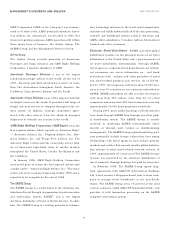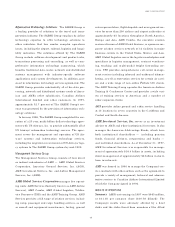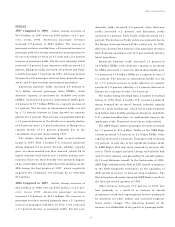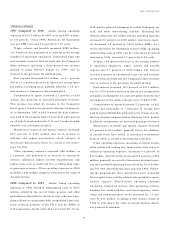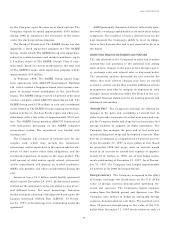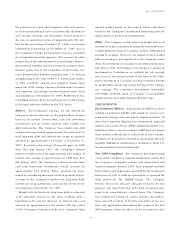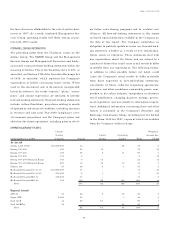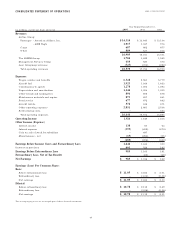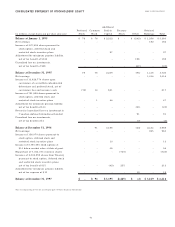American Airlines 1997 Annual Report Download - page 43
Download and view the complete annual report
Please find page 43 of the 1997 American Airlines annual report below. You can navigate through the pages in the report by either clicking on the pages listed below, or by using the keyword search tool below to find specific information within the annual report.
AMR CORPORATION
41
1996 Compared to 1995 Operating expenses increased
9.8 percent, or $49 million, due to a $27 million increase
in wages, salaries and benefits resulting from an increase
in the average number of equivalent employees and a $22
million increase in other operating expenses commensu-
rate with the increase in revenues.
OTHER INCOME (EXPENSE)
Other income (expense) for 1996 included a $251 mil-
lion charge associated with the Company’s relationship
with Canadian. This charge included $192 million relat-
ed to the write-off of AMR’s investment in the cumulative
mandatorily redeemable convertible preferred stock of
Canadian and $59 million related to the write-off of cer-
tain deferred costs relating to AMR’s agreement to provide
a variety of management, technical and administrative
services to Canadian.
LIQUIDITY AND CAPITAL RESOURCES
Operating activities provided net cash of $2.9 billion in
1997, $2.7 billion in 1996 and $2.2 billion in 1995. The
$204 million increase from 1996 to 1997 resulted
primarily from an increase in the air traffic liability due to
higher advanced sales. The $536 million increase from
1995 to 1996 resulted primarily from increased net
earnings and an increase in the air traffic liability due to
higher advanced sales and fare sale activity in late 1996
compared to 1995.
Capital expenditures in 1997 totaled $1.4 billion,
compared to $547 million in 1996 and $928 million in
1995, and included purchase deposits on new aircraft
orders of $745 million, purchases of computer related
equipment totaling $207 million and the acquisition of
seven ATR aircraft. These expenditures, as well as the
expansion of certain airport facilities, were funded pri-
marily with internally generated cash. Proceeds from the
sale of equipment and property of $281 million in 1997
include proceeds received upon the delivery of three of
American’s McDonnell Douglas MD-11 aircraft to Feder-
al Express Corporation (FedEx) in accordance with the
1995 agreement between the two parties.
At December 31, 1997, the Company had commit-
ments to acquire the following aircraft: 75 Boeing 737-
800s, 12 Boeing 757-200s, 11 Boeing 777-200IGWs,
eight Boeing 767-300ERs, 42 Embraer EMB-145s, 25
Bombardier CRJ-700s and five ATR 72s (Super ATR).
Deliveries of these aircraft commence in 1998 and will
continue through 2004. Future payments, including esti-
mated amounts for price escalation through anticipated
delivery dates for these aircraft and related equipment, will
approximate $1.5 billion in 1998, $1.9 billion in 1999,
$560 million in 2000 and an aggregate of $1.5 billion in
2001 through 2004. In addition to these commitments for
aircraft, the Company expects to spend approximately
$1.5 billion related to modifications to aircraft, renova-
tions of, and additions to, airport and office facilities, and
the acquisition of various other equipment and assets in
1998, of which approximately $700 million has been
authorized by the Company’s Board of Directors. While
the Company expects to fund the majority of its capital
expenditures from the Company’s existing cash balance
and internally generated cash, some new financing may be
raised depending upon capital market conditions and the
Company’s evolving view of its long-term needs.
In March 1998, the Company exercised its purchase
rights to acquire two additional Boeing 777-200IGWs for
deliveries in 1999. Depending upon the Company’s fleet
requirements, the Company may exercise additional air-
craft purchase rights throughout the remainder of 1998.
Also in March 1998, the Company exercised its option to
sell its remaining seven MD-11 aircraft to FedEx with
deliveries between 2000 and 2002.
The new collective bargaining agreement reached
between American and the Allied Pilots Association
granted pilots options to purchase 5.75 million shares of
AMR common stock at $83.375, $10 less than the aver-
age fair market value of the stock on the date of grant,
May 5, 1997. The options were immediately exercisable.
To offset the potential dilution from the exercise of these
options, the Company repurchased 5.75 million shares of
its common stock during 1997. Also in July 1997, the
Company initiated a stock repurchase program for up to
an additional $500 million of its outstanding common
stock, to be purchased in the open market or in private
transactions from time to time over a 24-month period.
As of December 31, 1997, a total of 7,043,375 shares had
been purchased by the Company under the two programs
at a total cost of approximately $740 million, and pro-
ceeds of approximately $200 million had been received





